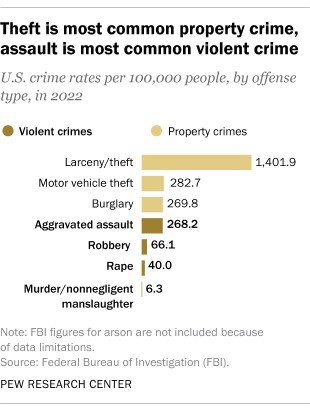US Crime Rates: Facts and Figures
The United States, like any nation, has a complex relationship with crime. Public perception, often influenced by media portrayals, can diverge significantly from the actual data. This article aims to provide a factual overview of crime trends in the US, relying on data from reputable sources such as the FBI, the Bureau of Justice Statistics (BJS), and academic research.
A Historical Overview
To understand current trends, it’s crucial to examine historical data. Crime rates in the US experienced a dramatic surge during the 1970s and early 1980s, peaking in the early 1990s.
This period is often referred to as the “crime wave.” However, a subsequent and sustained decline began in the mid-1990s, continuing into the early 2000s.
Several factors contributed to this decline:
Economic factors: Improved economic conditions often correlate with lower crime rates.
Law enforcement strategies: Innovations in policing, such as community policing and the use of data analytics, have been credited with reducing crime.
Demographic shifts: Changes in the age distribution of the population, with a smaller proportion of young males, have been linked to lower crime rates.
Incarceration rates: The significant increase in incarceration rates during the 1990s might have contributed to the crime decline, though this is a complex and debated issue.
Recent Trends
While the overall crime rate has declined significantly since its peak, there have been fluctuations in recent years. For instance, some cities experienced increases in homicides in 2020 and 2021. However, it’s essential to view these spikes in context. Crime rates remain substantially lower than those of the 1990s.
Violent Crime
Violent crime, encompassing murder, rape, robbery, and aggravated assault, has shown a general downward trend since the early 1990s. However, as mentioned, some fluctuations have occurred in recent years. It’s important to note that media coverage of violent crime often disproportionately represents certain types of offenses and geographic areas, potentially distorting public perception.
Property Crime
Property crime, including burglary, larceny-theft, and motor vehicle theft, has also declined over the long term. However, like violent crime, there have been short-term fluctuations. The increasing prevalence of technology has introduced new forms of property crime, such as identity theft and cybercrime.
Geographic Variations
Crime rates vary significantly across the United States. Urban areas generally have higher crime rates than rural areas. However, this is not a universal rule, and there are exceptions to this pattern. Factors such as economic inequality, poverty, unemployment, and social cohesion can influence crime rates at the local level.
The Role of Data and Methodology
Understanding crime trends is complex and requires careful analysis of data. It’s essential to consider the limitations of available data, such as the potential for underreporting of crimes, changes in crime reporting practices, and differences in data collection methods across jurisdictions.
Additionally, correlations do not necessarily imply causation. While certain factors may be associated with crime rates, establishing definitive cause-and-effect relationships is often challenging.
The Impact of Media and Public Perception
Media coverage of crime can significantly influence public perception. The tendency to focus on sensational cases and high-profile incidents can create a distorted picture of the overall crime situation. This can lead to fear and anxiety, even in areas with relatively low crime rates.
Conclusion
Crime is a complex issue with multiple causes and consequences. While the overall trend in the United States has been downward, there are still significant challenges to address. By understanding the data and avoiding generalizations based on media portrayals, it’s possible to develop effective crime prevention and response strategies.
Note: This article provides a general overview of crime trends in the United States. For a more in-depth analysis, it’s recommended to consult specific studies, reports, and data from reputable sources.



